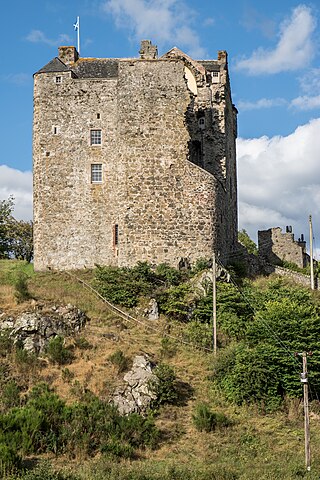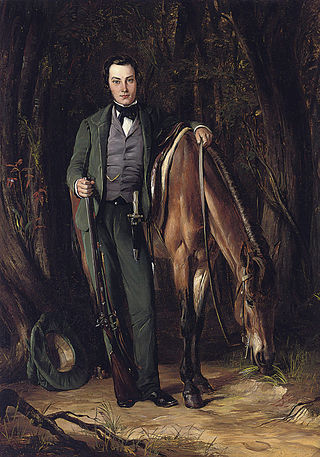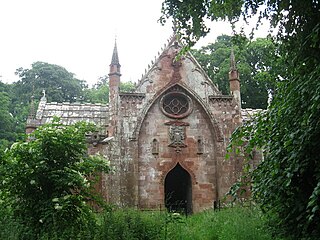
Marquess of Tweeddale is a title of the Peerage of Scotland, created in 1694 for the 2nd Earl of Tweeddale. Lord Tweeddale holds the subsidiary titles of Earl of Tweeddale, Earl of Gifford (1694), Viscount of Walden (1694), Lord Hay of Yester (1488), and Baron Tweeddale, of Yester in the County of Haddington (1881), all but the last in the Peerage of Scotland. As Baron Tweeddale in the Peerage of the United Kingdom, Lord Tweeddale sat between 1881 and 1963 in the House of Lords. The Marquess's eldest son uses Viscount Walden as a courtesy title.

Neidpath Castle is an L-plan rubble-built tower house, overlooking the River Tweed about 1 mile (1.6 km) west of Peebles in the Borders of Scotland. The castle is both a wedding venue and filming location and can be viewed by appointment.

Field Marshal George Hay, 8th Marquess of Tweeddale, was a British soldier and administrator. He served as a staff officer in the Peninsular War under Arthur Wellesley and was with Wellesley at the Second Battle of Porto when they crossed the Douro river and routed Marshal Soult's French troops in Porto. Hay also saw action at the Battle of Bussaco and at the Battle of Vitoria. He later served in the War of 1812 and commanded the 100th Regiment of Foot at the Battle of Chippawa when he was taken prisoner of war. He went on to become governor of Madras and, at the same time, Commander-in-Chief of the Madras Army, in which role he restored the discipline of the army, which had been allowed to fall into a relaxed state.

John Hay, 2nd Marquess of Tweeddale PC was a Scottish nobleman.
John Hay (1838–1905) was an American politician; Secretary of State 1898–1905.

John Hay, 4th Marquess of Tweeddale, was a Scottish nobleman.
Hay is an English and Scottish surname, shortened from the Scoto-Norman de la Haye. A common variation is Hayes, and to a lesser degree Haynes, Haines, or Hughes. Notable people with the surname include:

Yester Castle is a ruined castle, located 1+1⁄2 miles southeast of the village of Gifford in East Lothian, Scotland. The only remaining complete structure is the subterranean Goblin Ha' or Hobgoblin Ha' . It is a Scheduled Ancient Monument, recorded as such by the Royal Commission on the Ancient and Historical Monuments of Scotland.

James Smith was a Scottish architect, who pioneered the Palladian style in Scotland. He was described by Colen Campbell, in his Vitruvius Britannicus (1715–1725), as "the most experienced architect of that kingdom".

George Hay, Earl of Gifford was a British Liberal Party politician.

John Hay, 1st Marquess of Tweeddale was a Scottish peer and politician who served as Lord Chancellor of Scotland.
John Hay, 1st Lord Hay of Yester is the ancestor of the Marquesses of Tweeddale. He was created a Lord of Parliament on 29 January 1488 by James III of Scotland.
William Douglas, 2nd Earl of Angus was a Scottish nobleman and soldier. The son of George Douglas, 1st Earl of Angus and Princess Mary of Scotland, he was a grandson of King Robert III.
The Broun Baronets are a branch of the ancient Broun of Colstoun family whose estate near Haddington, East Lothian, remains to this day in the possession of a cadet family.

Yester Parish Church is a church of the Church of Scotland in the village of Gifford, East Lothian, Scotland. The village forms part of Yester, Bolton and Saltoun parish, and is a linked charge with Humbie Parish Church.

Yester Chapel is situated on the estate of Yester House, at the south-east edge of the village of Gifford in East Lothian, Scotland. The chapel is situated at grid reference NT544671. It is a Category A listed building.

William Montagu Hay, 10th Marquess of Tweeddale, KT, DL, known before 1878 as Lord William Hay or Lord William Montagu Hay, was a Scottish landowner, peer and politician. He was born at Yester House, near Gifford, East Lothian, and served in British India as a member of the Bengal Civil Service and later as a Liberal Member of Parliament.
William George Montagu Hay, 11th Marquess of Tweeddale JP was a Scottish aristocrat, land owner and soldier.
John Hay, 1st Earl of Tweeddale (1593–1653) was a Scottish aristocrat.
Charles Hay, 3rd Marquess of Tweeddale PC was a Scottish nobleman.














